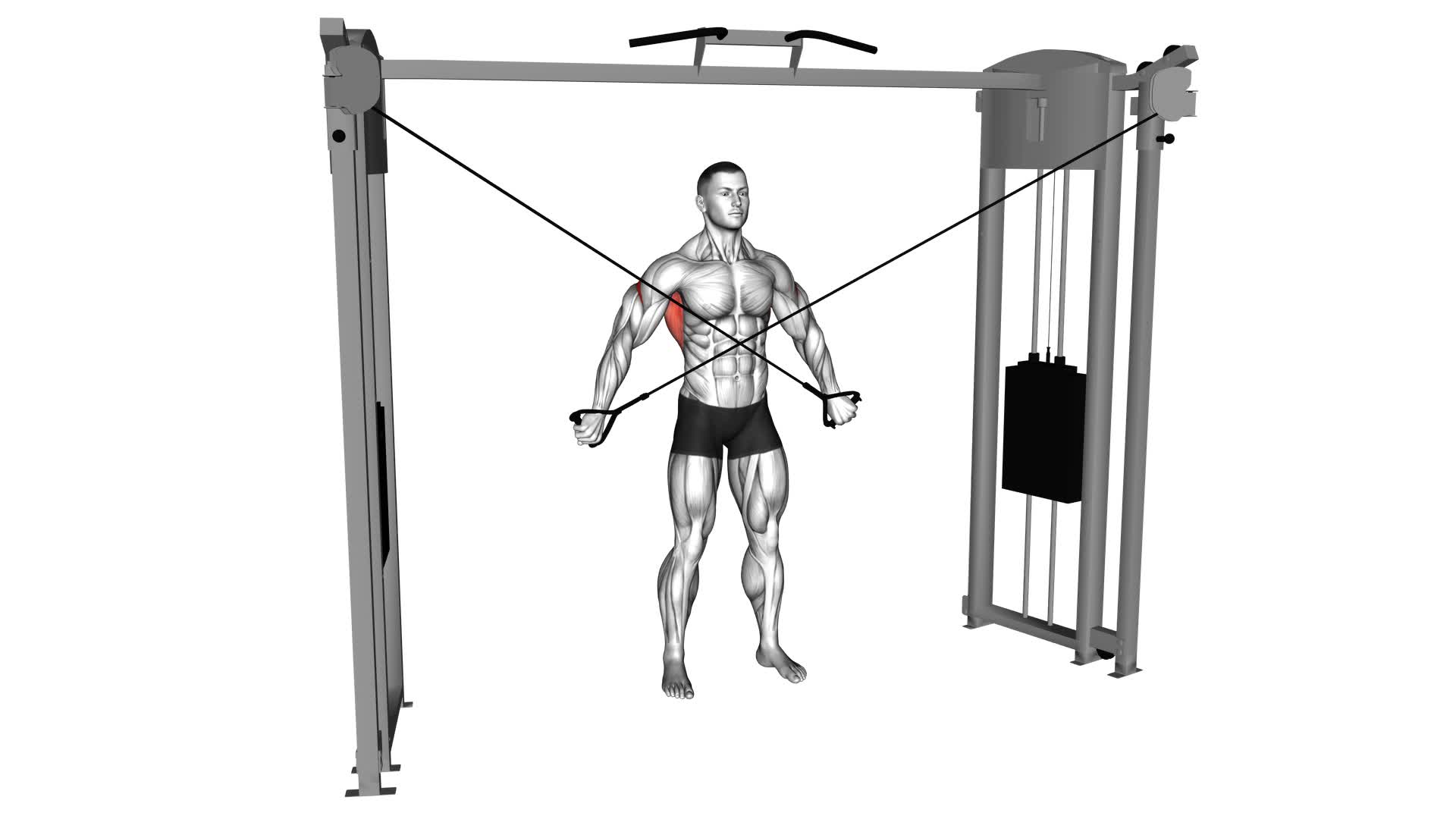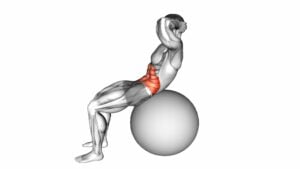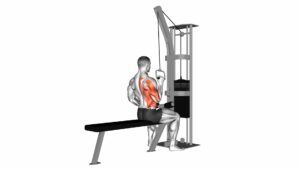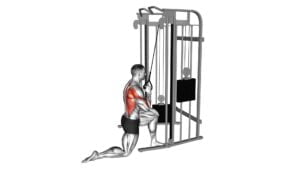Cable Lat Pulldown Full Range Of Motion – Video Exercise Guide & Tips

Are you looking to optimize your cable lat pulldown workout? In this article, we'll provide you with a video exercise guide and valuable tips to ensure you're getting the most out of your routine.
Watch This Exercise Video
Discover the benefits of performing full range of motion lat pulldowns, learn the proper form and technique, and find out which muscles you'll be targeting.
We'll also help you avoid common mistakes and provide variations and progressions to keep challenging yourself.
Get ready to maximize your lat muscle engagement!
Key Takeaways
- Full range of motion increases strength and muscle development
- Proper form and technique are essential for effective cable lat pulldowns
- Engaging the core during the exercise enhances stability and reduces the risk of injury
- Avoiding swinging or jerking and using controlled movements is important for targeting the lat muscles effectively
Benefits of Full Range of Motion
You can experience significant improvements in strength and muscle development by incorporating full range of motion in your cable lat pulldown exercises. By performing the exercise through its complete range of motion, you engage more muscle fibers, leading to greater muscle activation and growth. This increased muscle activation not only helps you build strength, but also enhances your overall muscle development.
In addition to improving strength, incorporating full range of motion in your cable lat pulldown exercises can also increase flexibility. The exercise requires a full stretch at the top of the movement and a complete contraction at the bottom. This helps to increase the flexibility of your lats, shoulders, and upper back muscles, allowing for better mobility and range of motion in everyday activities.
Proper Form and Technique
To perform the cable lat pulldown with proper form and technique, there are a few key points to keep in mind.
First, focus on engaging your core throughout the exercise to maintain stability and prevent excessive swinging or jerking movements.
Second, avoid using momentum to pull the cable down and instead, use controlled and deliberate movements to target your lat muscles effectively.
Lastly, remember to breathe properly, exhaling as you pull the cable down and inhaling as you release, to maintain stability and support your overall form.
Core Engagement During
Proper core engagement is crucial for maintaining stability during the cable lat pulldown exercise. To ensure optimal core stability and lat muscle activation, follow these tips:
- Keep your core muscles engaged throughout the exercise by bracing your abs and maintaining a neutral spine.
- Focus on pulling your shoulder blades down and back, activating your lats and maintaining proper posture.
- Imagine squeezing a pencil between your shoulder blades to engage the correct muscles.
- Avoid rounding your shoulders or arching your lower back, as this can lead to improper muscle activation and potential injury.
By engaging your core and lats properly, you'll enhance your stability, maximize the effectiveness of the exercise, and reduce the risk of injury.
Now, let's dive into the next section, which covers how to avoid swinging or jerking during the cable lat pulldown.
Avoiding Swinging or Jerking
Maintaining proper form and technique is essential to avoid swinging or jerking during the cable lat pulldown exercise. To prevent swinging, make sure to engage your core muscles and maintain control throughout the movement.
Avoid using momentum to pull the cable down, as this can lead to improper form and decrease the effectiveness of the exercise. Instead, focus on using your lat muscles to initiate and control the movement. Keep your shoulders down and back, and pull the cable down in a smooth and controlled manner.
Breathing Technique for Stability
To maintain stability and proper form during the cable lat pulldown exercise, focus on your breathing technique. Proper breathing can help you stabilize your core and maintain control throughout the movement.
Here are some tips for incorporating breathing exercises into your cable lat pulldown routine:
- Exhale during the pulling phase: As you pull the bar down towards your chest, exhale slowly and steadily. This helps engage your core and stabilize your body.
- Inhale during the return phase: As you release the bar and return to the starting position, inhale deeply. This allows you to reset and prepare for the next repetition.
In addition to incorporating breathing exercises, stability drills can also be beneficial for maintaining proper form during the cable lat pulldown. Practice exercises like planks, dead bugs, and bird dogs to improve your overall stability and enhance your performance in this exercise.
Muscles Targeted in Cable Lat Pulldown
When performing the cable lat pulldown, it's important to understand the muscles targeted and why proper form is crucial.
The primary muscle activated during this exercise is the latissimus dorsi, or lats, which are responsible for pulling your arms down and back.
Engaging these muscles correctly not only maximizes the effectiveness of the exercise but also helps prevent injury.
Lat Muscle Activation
Activate your lat muscles during the cable lat pulldown exercise by pulling the bar down towards your chest. Engaging your lats properly is crucial for maximizing the effectiveness of this exercise. Here are some key points to keep in mind for lat muscle activation:
- Focus on the movement: Concentrate on pulling the bar down using your lats rather than relying on your arms or shoulders.
- Squeeze your shoulder blades: As you pull the bar down, squeeze your shoulder blades together to fully engage your lats.
- Maintain proper form: Avoid using momentum or swinging your body during the exercise. Keep your back straight, chest up, and core engaged.
Proper activation of your lat muscles not only helps you build strength and size in your back but also reduces the risk of injury.
Proper Form Importance
As you focus on maintaining proper form during the cable lat pulldown exercise, it's important to understand the muscles that are targeted in this movement.
The cable lat pulldown primarily targets the latissimus dorsi, or the 'lats,' which are the muscles located on the sides of your back. However, this exercise also engages other muscles such as the rhomboids, biceps, and rear deltoids.
Proper form not only ensures effective muscle activation but also reduces the risk of injuries. By performing the exercise with the correct technique, you can maximize the benefits while minimizing the strain on your joints and muscles.
Flexibility plays a crucial role in maintaining proper form, as it allows for a full range of motion and prevents injuries. Transitioning into the next section about common mistakes to avoid, it's important to be aware of these errors to ensure a safe and effective workout.
Common Mistakes to Avoid
To prevent potential errors, ensure that you're maintaining proper form while performing the cable lat pulldown exercise. This won't only help you avoid injury but also maximize engagement of the targeted muscles. Here are some common mistakes to avoid:
- Using excessive momentum: Swinging your body or using momentum to pull the cable bar down takes away from the effectiveness of the exercise. Remember to keep your movements controlled and deliberate.
- Gripping the bar too wide or too narrow: Having an improper grip width can limit the activation of the lats and other back muscles. Aim for a grip that's slightly wider than shoulder-width to optimize muscle engagement.
To get the most out of your cable lat pulldown exercise, make sure to avoid these common mistakes. By maintaining proper form and avoiding excessive momentum or improper grip width, you'll be able to effectively target your back muscles and achieve better results.
Now that you're aware of the common mistakes to avoid, let's move on to the next section about variations and progressions of the cable lat pulldown exercise.
Variations and Progressions
Once you have mastered the basic cable lat pulldown exercise, you can progress to more advanced variations to further challenge your back muscles. These progression variations and exercise modifications can help you continue to build strength and improve your overall fitness.
One way to increase the difficulty of the cable lat pulldown is to use a wider grip. By placing your hands wider apart on the bar, you'll engage your back muscles in a slightly different way, providing a new stimulus for growth.
Another variation is the close grip cable lat pulldown, where you bring your hands closer together on the bar. This variation places more emphasis on your middle back and can help develop a stronger mind-muscle connection.
Another way to progress the exercise is by using different attachments or handles. For example, you can use a V-bar attachment or a rope attachment instead of the traditional straight bar. These variations can target different areas of your back and challenge your muscles in new ways.
Finally, you can incorporate other exercises into your cable lat pulldown routine to further enhance your back training. For example, you can perform a kneeling cable lat pulldown, which requires more core stability and engages your lower back muscles. You can also try a single-arm cable lat pulldown, which helps to correct muscle imbalances and improve overall strength.
Tips for Maximizing Lat Muscle Engagement
To maximize your lat muscle engagement, focus on using proper form and technique throughout the cable lat pulldown exercise. Here are some tips to help you maximize your lat muscle growth and get the most out of your lat exercises, especially if you're a beginner:
- Start with a weight that allows you to perform the exercise with proper form. Avoid using too much weight, as it can lead to poor technique and reduce lat muscle activation.
- Keep your back straight and your chest up throughout the entire movement. This will help maintain proper alignment and ensure that your lats are properly engaged.
- Squeeze your shoulder blades together as you pull the bar down. This will help activate your lats and create a stronger muscle contraction.
- Lower the weight slowly and with control, focusing on the eccentric portion of the movement. This will increase time under tension and further engage your lats.
- Avoid using momentum to complete the exercise. Instead, focus on a slow and controlled movement, emphasizing the contraction of your lat muscles.
- Consider incorporating other lat exercises into your workout routine, such as lat pull-ups and bent-over rows, to provide variety and target your lats from different angles.
Frequently Asked Questions
How Often Should I Perform Cable Lat Pulldown Exercises for Optimal Results?
For optimal results, you should perform cable lat pulldown exercises for muscle growth two to three times a week. However, the frequency may vary depending on your fitness level and goals.
To modify cable lat pulldowns for different fitness levels, you can adjust the weight, repetitions, or range of motion. It's important to listen to your body and gradually increase the intensity as you progress.
Consulting with a fitness professional can also provide personalized guidance.
Can Cable Lat Pulldowns Help Improve My Posture?
Cable lat pulldowns can greatly improve your posture. By targeting the muscles in your back, shoulders, and core, this exercise helps strengthen and stabilize your upper body, promoting better alignment and reducing the risk of slouching.
To maximize the benefits, it's important to maintain proper form and technique. Engage your lats, keep your shoulders back, and avoid using momentum.
Performing cable lat pulldowns regularly won't only enhance your posture but also contribute to overall strength and muscle development.
Is It Necessary to Use a Specific Grip Width for Cable Lat Pulldowns?
When performing cable lat pulldowns, you may wonder if using a specific grip width is necessary. The answer is yes, grip variations are important.
Using a wide grip for cable lat pulldowns can provide several benefits. It helps target the outer back muscles, promotes better posture, and increases the range of motion.
Are There Any Alternative Exercises That Target the Same Muscles as Cable Lat Pulldowns?
If you're looking for alternative exercises that target the same muscles as cable lat pulldowns, there are a few options you can try.
One option is the bent-over row, which works the same muscle groups in your back.
Another alternative is the pull-up, which also engages your lats.
Additionally, you can consider using resistance bands for lat pulldown variations.
These exercises can provide a similar muscle targeting effect as cable lat pulldowns.
Can Cable Lat Pulldowns Be Performed Using Resistance Bands Instead of a Cable Machine?
Resistance bands can be used as an alternative to cable machines for lat pulldowns. They provide a different type of resistance that engages your muscles in a slightly different way.
One of the benefits of resistance band lat pulldowns is that they allow for a greater range of motion and flexibility. They're also portable and can be easily used at home or while traveling.
Conclusion
In conclusion, incorporating full range of motion in the cable lat pulldown exercise can provide numerous benefits, including increased muscle activation and improved strength gains.
It's essential to maintain proper form and technique to target the lat muscles effectively and avoid common mistakes.
Additionally, varying the grip and using progressions can help keep the exercise challenging and promote muscle growth.
By following these tips, you can maximize your lat muscle engagement and enhance your overall workout effectiveness.

Author
Years ago, the spark of my life’s passion ignited in my mind the moment I stepped into the local gym for the first time. The inaugural bead of perspiration, the initial endeavor, the very first surge of endorphins, and a sense of pride that washed over me post-workout marked the beginning of my deep-seated interest in strength sports, fitness, and sports nutrition. This very curiosity blossomed rapidly into a profound fascination, propelling me to earn a Master’s degree in Physical Education from the Academy of Physical Education in Krakow, followed by a Sports Manager diploma from the Jagiellonian University. My journey of growth led me to gain more specialized qualifications, such as being a certified personal trainer with a focus on sports dietetics, a lifeguard, and an instructor for wellness and corrective gymnastics. Theoretical knowledge paired seamlessly with practical experience, reinforcing my belief that the transformation of individuals under my guidance was also a reflection of my personal growth. This belief holds true even today. Each day, I strive to push the boundaries and explore new realms. These realms gently elevate me to greater heights. The unique combination of passion for my field and the continuous quest for growth fuels my drive to break new ground.







